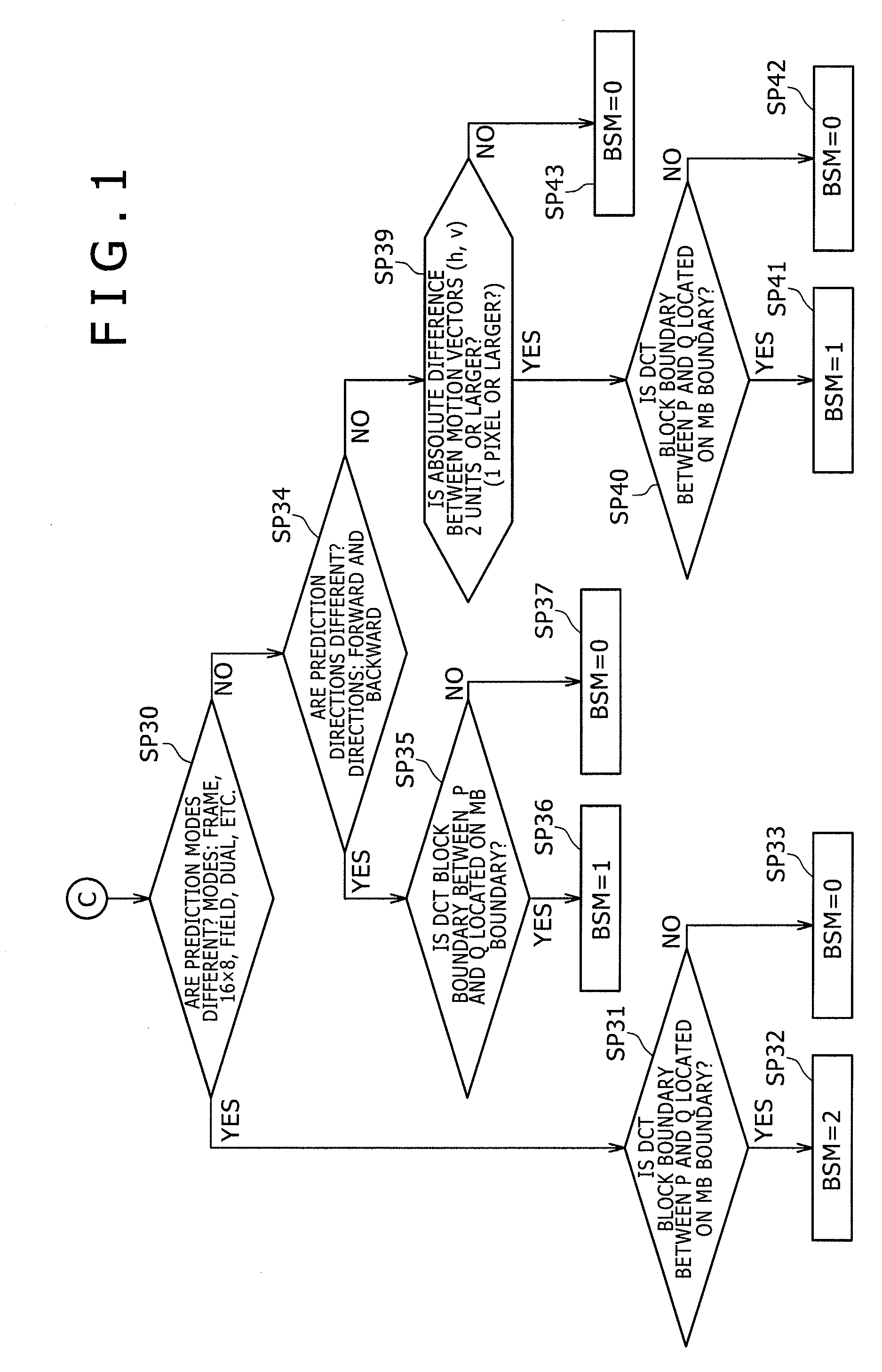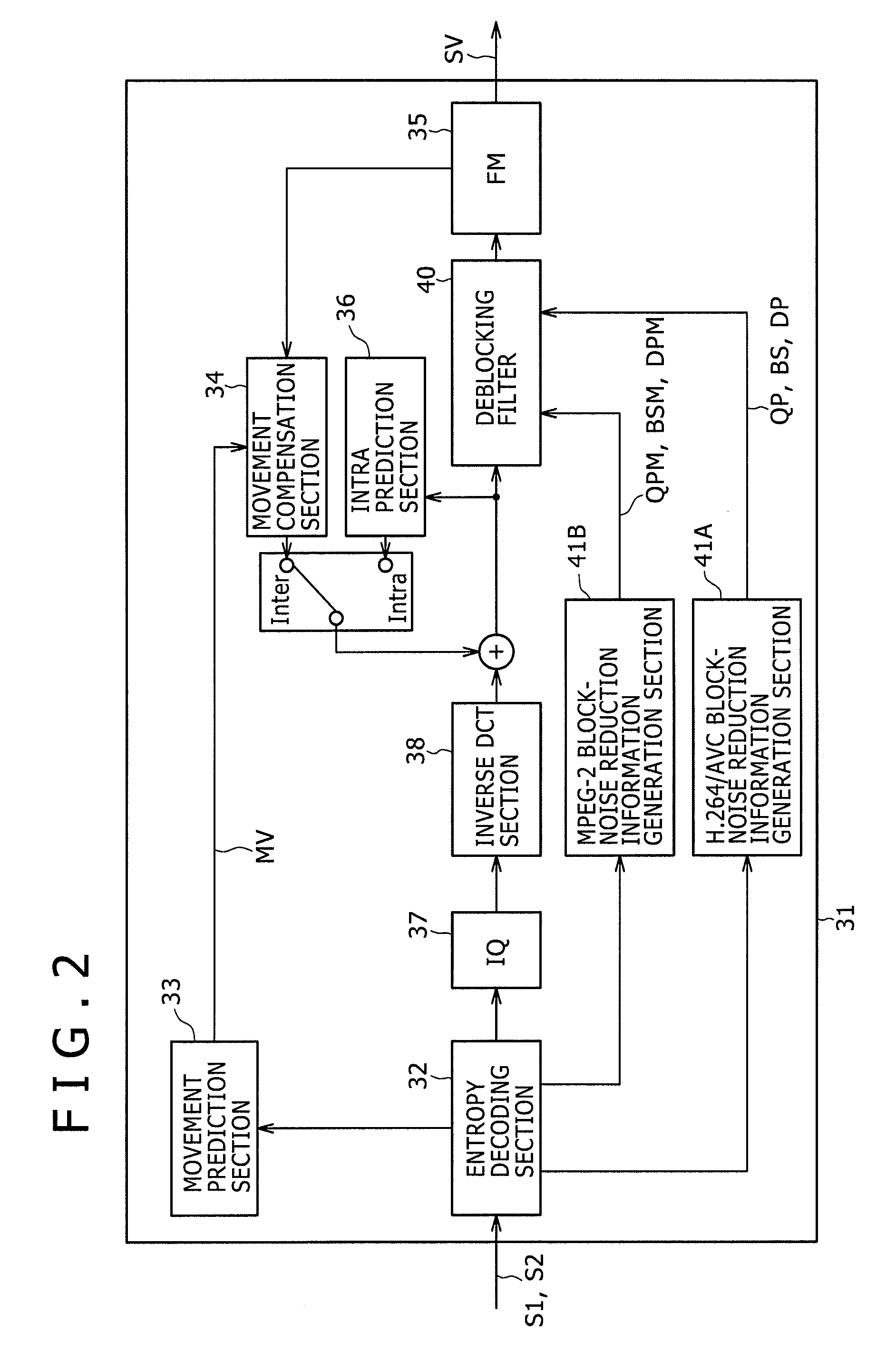Picture processing apparatus, picture processing method, picture processing method program and picture processing method program recording medium
a picture processing apparatus and picture processing method technology, applied in the field of picture processing apparatus, picture processing method program and picture processing method program recording medium, can solve the problems of high-frequency components lost in the quantization process, prediction error also increases, and the effect of removing block noise, simple configuration and high degree of reliability
- Summary
- Abstract
- Description
- Claims
- Application Information
AI Technical Summary
Benefits of technology
Problems solved by technology
Method used
Image
Examples
first embodiment
[0060](1) Constitution of the Embodiment
[0061]FIG. 2 is a block diagram showing the configuration of a decoding apparatus 31 according to a first embodiment of the present invention. The decoding apparatus 31 is a decoding apparatus capable of decoding both an MPEG-2 bit stream S1 and an H.264 / AVC bit stream S2. The decoding apparatus 31 is provided with a controller for switching the components of the decoding apparatus 31 from operations for processing the MPEG-2 bit stream S1 to operations for processing the H.264 / AVC bit stream S2 and vice versa so as to enable the decoding apparatus 31 to decode an MPEG-2 bit stream S1 or an H.264 / AVC bit stream S2. The controller itself is not shown in the figure though.
[0062]In the decoding apparatus 31, an entropy decoding section 32 carries out an entropy decoding process as a part of the decoding processing, which is being carried out by the decoding apparatus 31, on an MPEG-2 bit stream S1 or an H.264 / AVC bit stream S2 by properly switchi...
second embodiment
[0201]It is to be noted that, in the case of the first embodiment explained so far, a filtering process can also be carried out for a vertical-direction inter-center-line gap between DCT block boundaries. However, the scope of the embodiments of the present invention is by no means limited to the first embodiment. For example, the difference in DCT type can also be taken into consideration in order to carry out the filtering process more finely. That is to say, in the case of a field structure shown in the diagram of FIGS. 19A and 19B, a DCT block noise Q to be removed and a DCT block noise P adjacent to the DCT block noise Q may exist in the same macroblock MB. Even in this case, the two block noises, i.e., the DCT block noise Q and the DCT block noise P, are generated as noises of blocks created from a top field and a bottom field which are different from each other from the time point of view. In this case, the relevance and resemblance of the two block noises, i.e., the DCT bloc...
third embodiment
[0202]FIG. 20 is a block diagram showing a coding apparatus 51 according to a third embodiment of the present invention. The coding apparatus 51 is a coding apparatus capable of generating both an MPEG-2 bit stream S1 and an H.264 / AVC bit stream S2. The coding apparatus 51 is provided with a controller for switching the components employed in the coding apparatus 51 from coding operations for the MPEG-2 bit stream S1 to coding operations for the H.264 / AVC bit stream S2 and vice versa so as to enable the coding apparatus 51 to generate an MPEG-2 bit stream S1 or an H.264 / AVC bit stream S2. The controller itself is not shown in the figure though. It is to be noted that components employed in the coding apparatus 51 shown in the block diagram of FIG. 20 as components identical with their respective counterparts employed in the decoding apparatus 31 shown in the block diagram of FIG. 2 are denoted by the same reference numerals as the counterparts and the explanation of the identical co...
PUM
 Login to View More
Login to View More Abstract
Description
Claims
Application Information
 Login to View More
Login to View More - R&D
- Intellectual Property
- Life Sciences
- Materials
- Tech Scout
- Unparalleled Data Quality
- Higher Quality Content
- 60% Fewer Hallucinations
Browse by: Latest US Patents, China's latest patents, Technical Efficacy Thesaurus, Application Domain, Technology Topic, Popular Technical Reports.
© 2025 PatSnap. All rights reserved.Legal|Privacy policy|Modern Slavery Act Transparency Statement|Sitemap|About US| Contact US: help@patsnap.com



